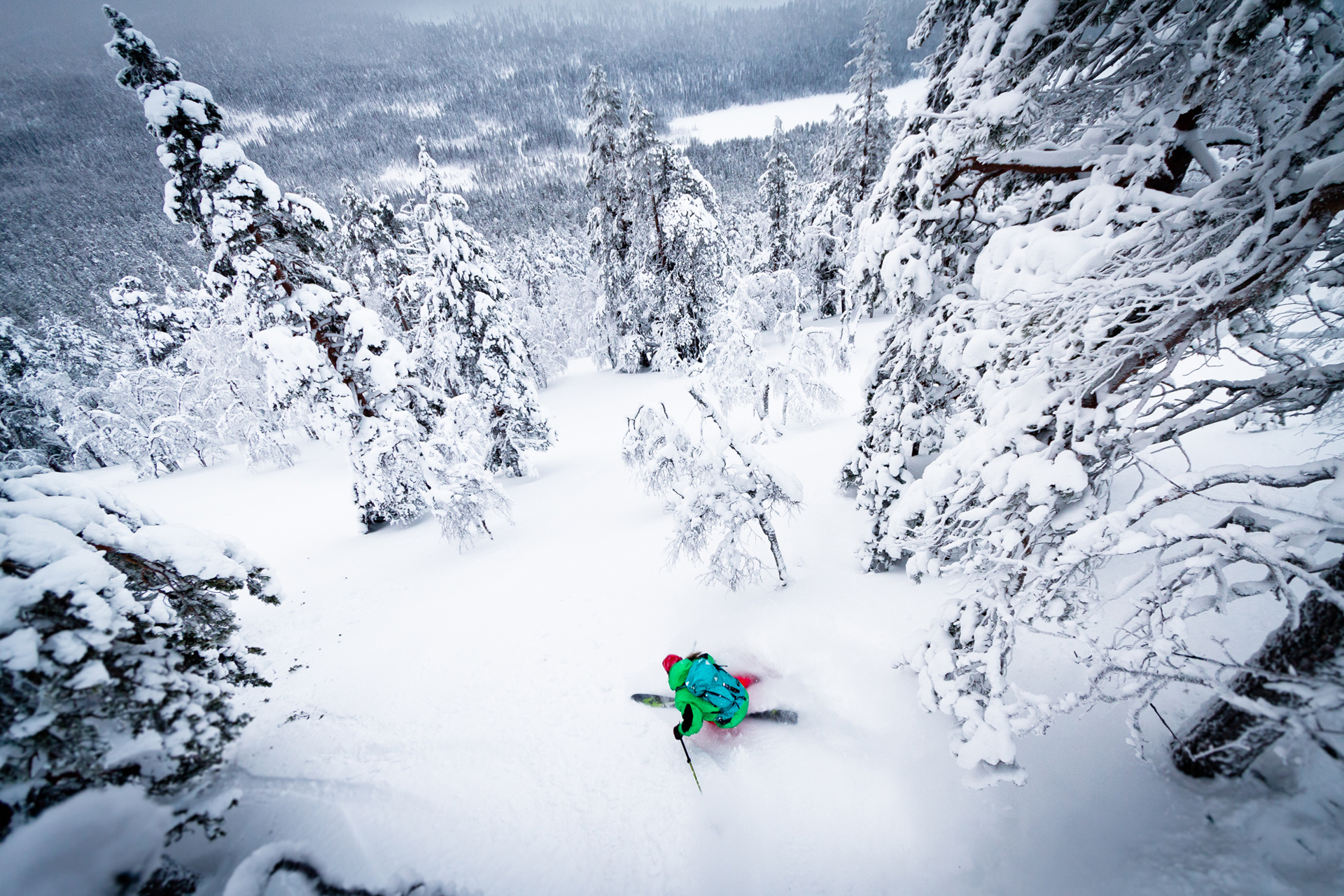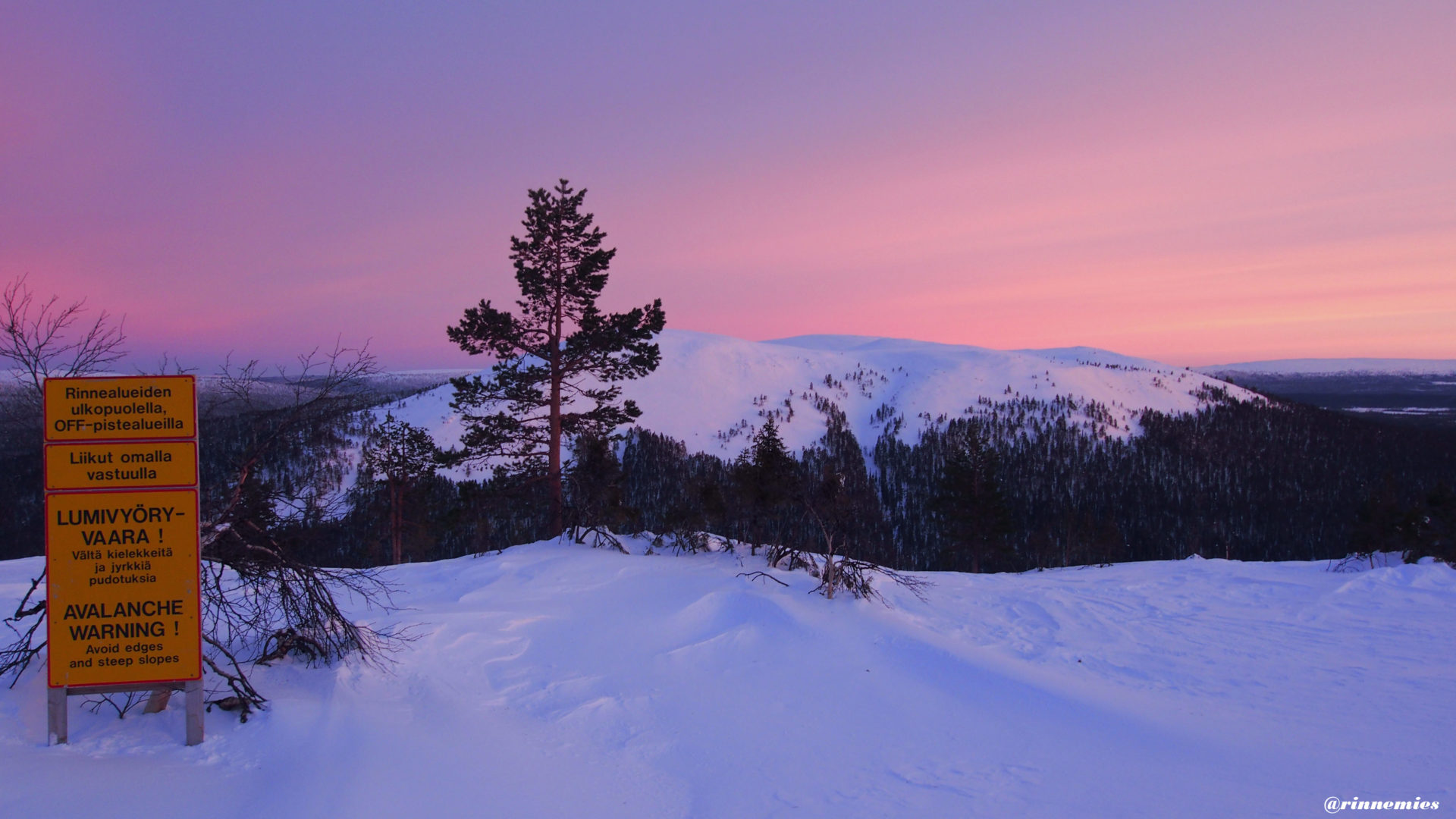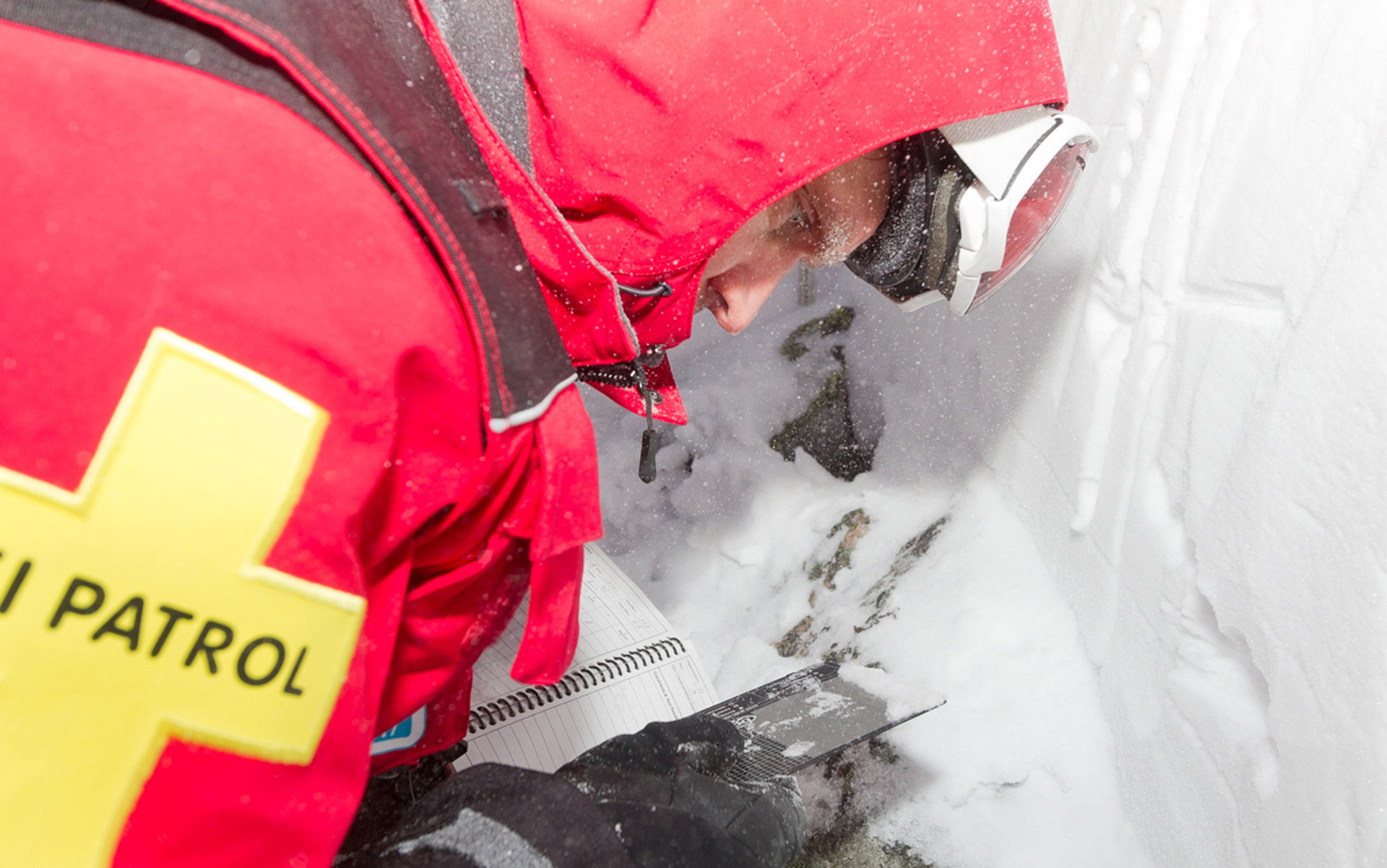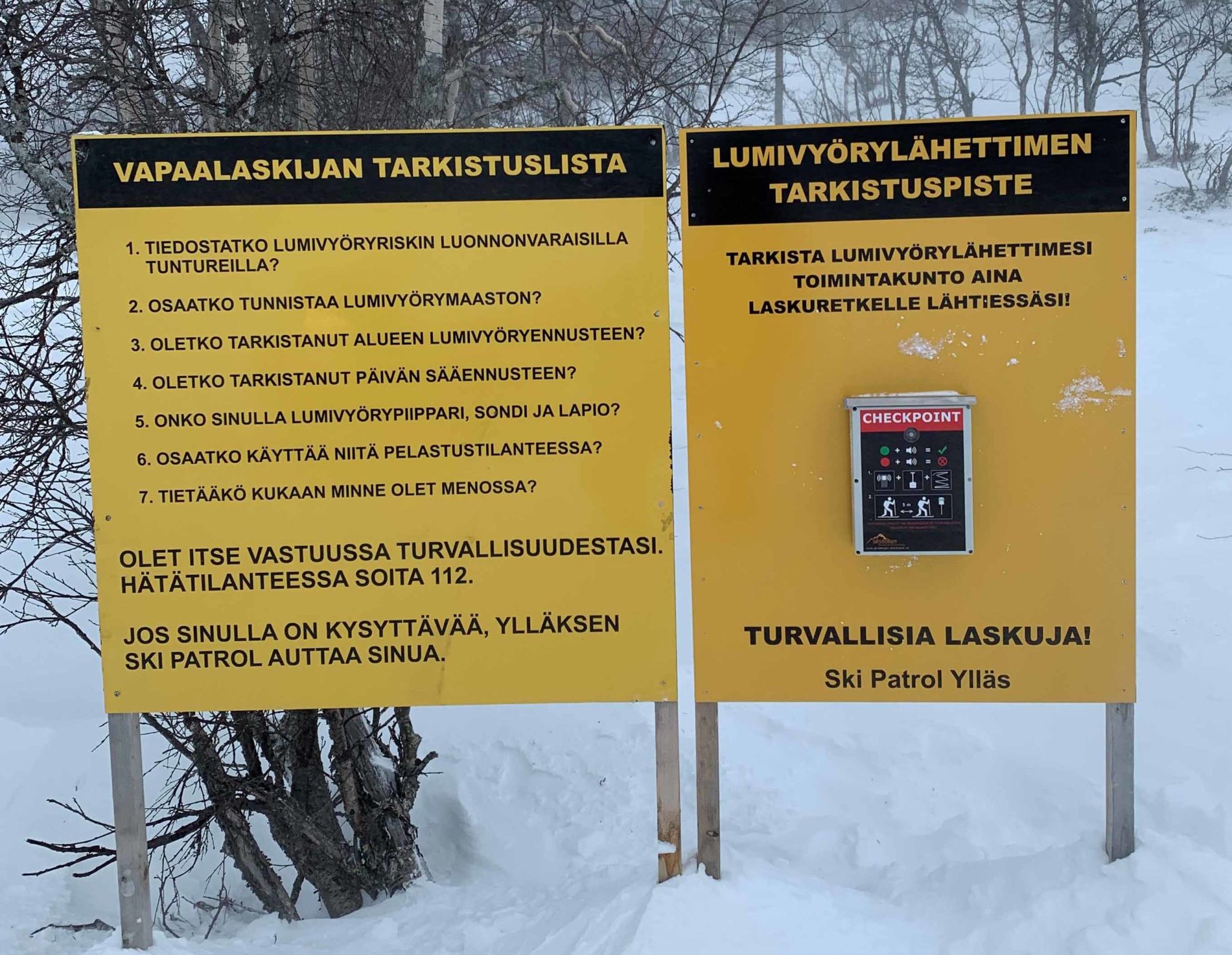Know the risks of snowy fells
There is no avalanche risk on the managed slopes at the Ylläs ski resort, but there are avalanches at the natural fells of the area every winter. The changing weather conditions and the increasing number of people have even increased the number of avalanches in recent years. Those moving around the backcountry – regardless of their means of transport – must be aware of the risk and stay out of avalanche terrain.
For off-piste skiers, the solid elements on the ground, such as stones, trees and stumps, pose a more likely risk for injury than avalanches. Getting lost and tired in remote places and frostbite can also put the backcountry skills of skiers to the test.

Ski patrol Ylläs – experts in snow
Strictly speaking, the ski resort is not responsible for the safety of fells outside the ski resort area, but Ski Patrol Ylläs has promoted their safety through volunteer work since its establishment. The patrol has trained and prepared itself for avalanches since the 1990s, and over the three decades, Ylläs has become the leading expertise centre in ski touring and avalanche safety in Finland. In addition to excellent routes and terrain, Ylläs offers professional and up-to-date training in freeriding.
Our most experienced patrollers have completed the CAA Avalanche Operations, Level 2 professional training, which means they can use the title of avalanche expert.
Freeriding requires specialist skills
Freeriders heading to fells and mountains that are in their natural state need special equipment, both for moving and to prepare for avalanches.
An avalanche beacon, probe and shovel are the basic kit everyone should pack with them and know how to use. However, even more important is good advance preparation and the ability to avoid dangerous areas. For this reason, it is extremely important to understand the weather, snow phenomena and the constantly changing avalanche risk.
FINLAV courses in freeriding
FINLAV – Finnish Avalanche Education system is managed by the Finnish Ski Area Association, and its aim is to increase the knowledge and understanding of avalanche risks among the general population. FINLAV provides high-quality, up-to-date training on safety in areas that are prone to avalanches that meet international standards.
The avalanche experts and technical avalanche experts of Ski Patrol Ylläs have all been authorised as avalanche safety instructors by the Finnish Avalanche Education system. Ylläs organises several avalanche safety courses every year, and these courses offer a solid foundation for your freeriding hobby.
Courses in the 2021–2022 season
You can register for the Ski Patrol courses by clicking on the links below. The course descriptions are behind the links.
Avalanche forecasts
The Ski Patrol avalanche forecast team prepares local avalanche forecasts for the natural fells at Ylläs. These forecasts have been published to support the decisions made by off-piste skiers since the 2016–2017 season. Ylläs was the first ski resort in Finland to start a local avalanche forecast service. Before that, the patrol cooperated with the avalanche forecast unit of the Finnish Meteorological Institute as the partner that collected data on the field, and this cooperation that started in 2003 still continues. The ski patrol’s forecast covers the seven fells in Ylläs, whereas the regional forecast of the FMI is made for the more extensive Ylläs-Levi area.
Avalanche preparedness
Even small areas of 10 x 10 metres can be prone to avalanches, if they have steep terrain. Usually, slopes greater than 30 degrees are considered steep, but humans can trigger an avalanche even on slopes that are 25 degrees steep, if the other typical conditions for avalanches are present.
In the case of an avalanche, professional help often arrives too late because humans cannot survive under the snow for a very long time. Therefore, every freerider should be able to rescue their partner, which places significant emphasis on peer rescuing skills. You must master the use of the avalanche safety equipment in order to be able to use them under pressure. This requires continuous practice and training.
Ylläs offers excellent opportunities for this. The ski school in Äkäslompolo has the Pieps beacon practice system that enables building different scenarios quickly and practising effectively in a realistic setting. You can participate on a group course or book a private practice time for yourself or a group.
Avalanche beacon test station
There is a test station for avalanche beacons at the Äkäslompolo ski resort. The station is located at the base of the Varkaankuru, near the substation of the Jokeri lifts, at the start of the route to the Pallas-Yllästunturi National Park.
Calling for help in the backcountry
In all emergencies, call the emergency number – 112. Download the 112 app on your phone!
Safety instructions for freeriding
- If you want to go off-piste, you always do so at your own risk. Remember to check your insurance coverage!
- Never ski alone in the backcountry. Your partner may be your only savior if you encounter an accident in the backcountry, because professional help often takes a long time to arrive in remote areas
- Plan your route in advance with the help of a map, taking into account the weather forecast, avalanche forecast and the skills and abilities of the party
- Download the 112 app on your phone. The app is the fastest way to call for help and it sends your exact location to the rescuers, which means that you will get help as soon as possible
- Report all avalanches to 112 even if you do not need help. If the authorities have no first-hand information from the affected area, the rescue team might start a massive rescue operation because of an alarm raised by a bystander who sees the avalanche from afar
- Be prepared for changing weather, incidents and accidents by packing enough extra clothes, drinks and food. You should always have a pair of ski glasses, a headtorch and a first aid kit, just in case
- Before your tour, tell someone where you are going and when you intend to return. Remember to let them know when you have returned
- Check the weather and avalanche forecasts one more time just before you set off and make changes to the route plan, if needed. Do not hesitate to postpone your trip if you are having second thoughts about the conditions or the current abilities of your party
- Test everybody’s avalanche beacons before you head into the backcountry and after long breaks. Make sure that everyone has also brought a probe and a shovel with them. Avalanche rescue kits should be prepared and ready for use at the start of the trip
@skipatrol_yllas
Maanantain vesisade on lisännyt lämpöenergiaa lumipeitteeseen kiihdyttäen sen valumista ja heikentäen lumipeitteen vakautta. Syvemmällä lumipeitteessä olevat pitkään säilyvät heikot kerrokset voivat reagoida yksittäisen liikkujan alla ohuen lumipeitteen alueilla.
Pääset lukemaan päivitetyn lumivyöryennusteen profiilin linkistä.
#avalancheforecasting #skipatrol_yllas #visitylläs

Avotunturialueille luvataan yön aikana navakkaa pohjoisen suuntaista tuulta, joka kuljettaa osittain kosteaa pintalunta tuulen suojan puoleisille alueille. Kuvassa suojapuolelle muodostunutta tuiskulumen laattaa, joka reagoi hiihtäjän painoon. Päivitetyn lumivyöryennusteen löydät profiilin linkistä.
#skipatrol_yllas #avalancheforecasting #visityllas

Lumikiteiden väliset sidokset näyttelevät suurta osaa lumivyöryjen muodostumisessa, sillä lumen vahvuus on suuresti riippuvainen näistä sidoksista.
Alkuviikosta saatiin Kellostapulin pohjoispuolella havainnoida lumikiteiden sitoutumista mielenkiintoisella tavalla.
Oheisella videolla näkee ensinnäkin sen, että lumipeitteen pinnalle muodostuneessa ohuessa kansikerroksessa kiteet ovat sitoutuneet toisiinsa erityisen hyvin, kun taas toisekseen kyseisen kerroksen kiinnittyminen alempaan lumipeitteeseen on ollut tuolla hetkellä erityisen huono.
Jos tuossa vaiheessa olevalle lumipeitteelle olisi saatu runsaasti uutta lunta päälle joko satamalla tai tuulen tuomana, olisi lumivyöryvaara kasvanut hetkessä.
Uutta lunta ei ole kuitenkaan tuntureille juurikaan satanut ja lauhan sään aikana lumipeitteen lämpötila on kokonaisuudessaan noussut yli miinus 5 asteen ja lumipeite on stabilisoitumassa lumikiteiden sidoksien vahvistuessa.
Pääset aina lukemaan tuoreimman lumivyöryennusteen profiilin linkistä.
#skipatrol_yllas #avalancheforecasting #visityllas

Sunnuntaina Ylläksen yli liikkuva kylmä rintama tuo alueelle sadetta useissa eri olomuodoissa. Lumipeiteessä oleva pitkään säilyvä heikko kerros voi muuttua reaktiiviseksi sateen ja lämpötilan lauhtumisen johdosta. Lue päivitetty ennuste profiilin linkistä.
#skipatrol_yllas #visityllas #avalancheforecasting

Talven sää on ollut varsin vaihtelevaa ja tuulista. Useat lauhat föhn-tuulet ja tuuliset jaksot ovat kuljettaneet lunta pois avotunturista, ja turvallisesti laskettavia linjoja on varsin vähän. Tiistai-iltana lämpötila painui taas pakkaselle ja lumen pinta on muuttunut kovaksi ja varsin liukkaaksi.
Päivitetty ennuste löytyy profiilin linkistä.
#skipatrol_yllas #visityllas #avalancheforecasting



